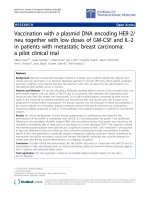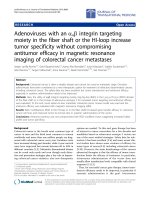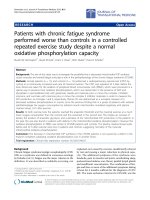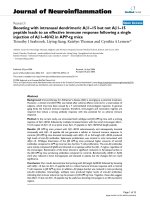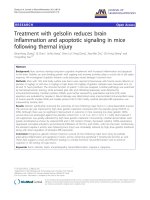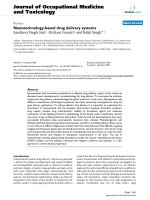Báo cáo hóa học: " Research Article Capacity of Wireless Ad Hoc Networks with Opportunistic Collaborative Communications" pdf
Bạn đang xem bản rút gọn của tài liệu. Xem và tải ngay bản đầy đủ của tài liệu tại đây (615.39 KB, 7 trang )
Hindawi Publishing Corporation
EURASIP Journal on Wireless Communications and Networking
Volume 2007, Article ID 53075, 7 pages
doi:10.1155/2007/53075
Research Article
Capacity of Wireless Ad Hoc Networks with Opportunistic
Collaborative Communications
O. Simeone and U. Spagnolini
Dipartimento di Elettronica e Informazione, Politecnico di Milano, Piazza Leonardo da Vinci 32, 20133 Milano, Italy
Received 17 January 2006; Revised 13 November 2006; Accepted 27 December 2006
Recommended by Christian Hartmann
Optimal multihop routing in ad hoc networks requires the exchange of control messages at the MAC and network layer in order to
set up the (centralized) optimization problem. Distributed opportunistic space-time collaboration (OST) is a valid alternative that
avoids this drawback by enabling opportunistic cooperation with the source at the physical layer. In this paper, the performance
of OST is investigated. It is shown analytically that opportunistic collaboration outperforms (centralized) optimal multihop in
case spatial reuse (i.e., the simultaneous transmission of more than one data stream) is not allowed by the transmission protocol.
Conversely, in case spatial reuse is possible, the relative performance between the two protocols has to be studied case by case in
terms of the corresponding capacity regions, given the topology and the physical parameters of network at hand. Simulation re-
sults confirm that opportunistic collaborative communication is a promising paradigm for wireless ad hoc networks that deserves
further investigation.
Copyright © 2007 O. Simeone and U. Spagnolini. This is an open access article distributed under the Creative Commons
Attribution License, which permits unrestricted use, distribution, and reproduction in any medium, provided the original work is
properly cited.
1. INTRODUCTION
Theemergenceofnovelwirelessservices,suchasmesh-
based wireless LANs and sensor networks, is causing a shift
of the interest of the communications community f rom
infrastruc ture-based wireless networks to ad hoc wireless
networks. While the theory of infrastructure-based wire-
less networks is by now fairly well developed, a complete
information-theoretic characterization of ad hoc wireless
networks is still far from being realized, even in the simplest
cases of relay channels or interference channels.
In recent years, landmark works that address this knowl-
edge gap have been published, by relying mostly on asymp-
totics or simplified assumptions. In [1], the scaling law of
the transport capacity (measured in bps per meter) versus
the number of nodes that was derived under the assump-
tion of a static network with multihop (MH) and point-
to-point coding. A different approach was pursued in [2],
where a general framework for the computation of the ca-
pacity region of wireless networks under given transmission
protocols was proposed. The protocols considered in [2] in-
cluded single/multihop transmission with or without spatial
reuse, power control, and successive interference cancella-
tion. Overall, the works reported above, and the literature
stemmed from these references, concentrate on MH and fail
to account for one of the most promising wireless transmis-
sion technologies, namely, cooperation (see, e.g., [3]). An at-
tempt in this direction was made in [4] where the capacity
region of an ad hoc network with single-relay amplify-and-
Forward (AF) transmission was studied.
A major observation in interpreting the capacity region
of [2] with MH is that in order to achieve the points on
the boundary of the region, optimal time-division schedul-
ing among the basic transmission schemes has to be em-
ployed. This requires coordination among the nodes on a
global level, which in turn implies the need for the exchange
of overhead information at higher layers of the protocol stack
(MAC and network) [5]. As a valid alternative, this paper
studies the performance of an ad hoc network under the col-
laborative space-time coding scheme investigated in [6](The
words “cooperation” and “collaboration” w ill be used inter-
changeably throughout the paper.). According to this strat-
egy, originally presented in the context of single-link relayed
transmission, cooperation with a tr ansmitting source occurs
opportunistically, that is, whenever an idle node is able to de-
code the transmitted signal before the intended destination.
2 EURASIP Journal on Wireless Communications and Networking
We refer to this scheme as opportunistic space-time collabora-
tion (OST).
1
In [6] an achievable rate for OST was derived
under the assumption that channel state information is only
available at the receiving side of each wireless link.
The main contribution of this paper is twofold. (1) It is
shown analytically that the (distributed) OST scheme out-
performs (centralized) optimal MH transmission in a sce-
nario where no spatial reuse is allowed (i.e., multiple concur-
rent tr ansmissions are not allowed). In other words, the ca-
pacity region achievable by OST is larger than that obtained
by MH. This conclusion is obtained by exploiting the results
in [6] and by casting the optimal MH problem of [2]ina
suitable framework. (2) If spatial reuse is employed, the in-
creased interference caused by the opportunistic transmis-
sion of idle nodes in OST can be deleterious to concurrent
transmissions, and optimized MH transmission may be ad-
vantageous in some cases. Simulation results show that the
relative performance of OST and MH for spatial reuse should
be studied case by case, given the topology and the physical
parameters of network at hand.
Notation
Lowercase (uppercase) bold denotes column vector (matrix);
v
i
denotes the ith element of the N ×1vectorv (i = 1, , N);
A
nm
is the (n, m)th element of the N × M matrix A (n =
1, , N, m = 1, , M).
2. SYSTEM MODEL
Consider an ad hoc network with n single-antenna nodes,
collected in the set N
= [1, , n]. Each node may want to
communicate (an infinite backlog of) data to another single
node (no multicast is allowed), possibly through MH or col-
laborative transmission. A node that generates a data st ream
is referred to as the source node for the given data stream,
whereas the node to which the data stream is finally intended
is called the destination. When active, each node transmits
with power P [W] and is not able to receive simultaneously
(half duplex constraint).
Apairofnodesi and j
∈ N is separated by a distance
d
ij
[m]; moreover, the wireless link between the ith and jth
nodes is characterized by a (Rayleigh) fading coefficient h
ij
∼
CN (0, 1). The overall channel power gain between the two
nodes reads
G
ij
= ρ
0
d
0
d
ij
α
h
ij
2
,(1)
where d
0
is a reference distance, α is the path loss exponent
and ρ
0
is an appropriate constant setting the signal-to-noise
ratio (SNR) at the reference distance. Notice that for reci-
procity, h
ij
= h
ji
and thus G
ij
= G
ji
.
1
Notice that the term opportunistic is used here in the same sense of [7],
where a practical (uncoded) implementation of OST is investigated.
Let us denote b y A ⊂ N the set of active (transmitting)
nodes at a given time instant. In a collaborative scenario,
possibly more than one node in A are active transmitting
to a given node j. Therefore, the set A can be partitioned
into nonoverlapping subsets A
j
,whereA
j
denotes the set of
nodes cooperating for transmission to j. Notice that trans-
mission from nodes in A
\A
j
causes interference on the re-
ception of node j. As for any collaborative technique that re-
quires the cooperating node to fully decode the signal (e.g.,
decode and forward (DF) schemes [3]), the nodes in A
j
are
assumed to have decoded the signal intended for node j by
the considered time instant. Moreover, assuming no channel
state information at the transmitter, the signals from differ-
ent cooperating nodes add incoherently at the receiver and
the resulting SINR for reception at node j reads
SINR
j
A
j
, A
=
k∈A
j
G
kj
P
N
0
B +
k∈A\A
j
G
kj
P
,(2)
where N
0
is the power spectral density of the background
noise [W/Hz] and B is the signal bandwidth. Notice that the
SINR for collaborative transmission (2) reduces to the stan-
dard SINR for a noncollaborative scenario in case only one
node is active for transmission to any receiving node j, that
is, A
j
={i}, i ∈ N . The channel capacity [bps] on the wire-
less link between the set of nodes A
j
and j is
C
j
A
j
, A
=
B · log
2
1 + SINR
j
A
j
, A
. (3)
3. COLLABORATIVE COMMUNICATIONS IN AD HOC
NETWORKS: NO SPATIAL REUSE
In this section, performance comparison between (central-
ized) optimal MH and the (distributed) OST scheme pro-
posed in [6] is presented in terms of achievable rates for ad
hoc networks with no spatial reuse (i.e., multiple concurrent
transmissions are not allowed). This requires to cast the opti-
mal MH problem into a convenient framework (Section 3.1)
and to exploit the results in [6] for the case where any num-
ber of nodes can collaborate with the ongoing transmission
(Section 3.2).
The discussed performance comparison between optimal
MH and the dist ributed OST scheme aims at showing that
the overhead of setting up a centralized optimization proce-
dure could be avoided by cooperative techniques at the phys-
ical layer without compromising (or even increasing) the sys-
tem perfor m ance. However, it should be noted that the com-
parison is not fair from the standpoint of the total transmis-
sion power employed by the network. In fact, the total trans-
mission power in the OST scheme is not directly controllable
due to lack of channel state information at the transmitters,
and may exceed the power spent by optimal MH. In energy-
constrained networks, it is then necessary to assess the best
solution as a trade-off between the energy needed to make
centralized MH optimization feasible and the extra tr a nsmis-
sion energy required by OST.
O. Simeone and U. Spagnolini 3
d = a
5
C
a
5
(a
4
)
a
4
C
a
4
(a
3
)
a
3
C
a
3
(a
2
)
a
2
C
a
2
(a
1
)
s
= a
1
a
1
a
2
a
2
a
3
a
3
a
4
a
4
a
5
t
0 f
1
f
1
+ f
2
f
1
+ f
2
+ f
3
f
1
+ f
2
+ f
3
+ f
4
= 1
Figure 1: Illustration of an MH route (M = 3hops).
3.1. Optimal multihop transmission
Consider Figure 1.Sourcenodes generates a data stream in-
tended for node d. Since we are focusing on a case with no
spatial reuse, only one source-destination pair is active. Ac-
cording to [2], maximizing the rate R
sd
between s and d en-
tails centralized optimization of the time schedule among the
˘
M
= n(n − 1) + 1 basic transmission modes allowed by the
MH protocol with no spatial reuse. Here, for convenience of
analysis, we restate the problem of maximizing R
sd
in the fol-
lowing equivalent way. Find (i) the sequence of M +1(with
0
≤ M ≤ n − 2) hops, that we denote by the (M +2)× 1vec-
tor a,witha
1
= s and a
M+2
= d; (ii) the (M +1)× 1optimal
scheduling vector f,where f
m
refers to the fraction of time
devoted for the hop from node a
m
to a
m+1
, such that
R
MH
sd
= max
{M,a,f}
min
m=1, ,M+1
f
m
C
a
m+1
a
m
(4)
is subject to
M+1
m=1
f
m
= 1, where we have defined for simplic-
ity of notation C
j
(A
j
) = C
j
(A
j
, A
j
)(recall(2)and(3)). See
Figure 1 for a pictorial view of the problem. From (4), it is
clear that the optimal MH route maximizes the bottleneck of
the weakest link along the route. Formulation of the optimal
MH problem as in (4) allows the performance comparison
with the OST scheme, as shown in the next section.
3.2. Opportunistic space-time cooperation
Consider again the situation in Figure 1. According to OST,
the source node star t s the transmission at a given rate R
sd
,not
being informed of whether the signal will arrive to the des-
tination directly or by collaborative transmission. As soon as
any node a
2
∈ N \A
(1)
d
(where A
(1)
d
={s} is the set of col-
laborating nodes) is able to decode the signal from s, it starts
transmitting a cooperating signal (see Figure 2). We denote
the (normalized) time instant when successful decoding of
d
a
2
C
a
3
(A
(2)
d
)
s
= a
1
a
3
A
(1)
d
a
2
A
(2)
d
a
3
A
(3)
d
a
4
A
(4)
d
a
5
t
A
(2)
d
={s, a
2
}
0 f
1
f
1
+ f
2
f
1
+ f
2
+ f
3
f
1
+ f
2
+ f
3
+ f
4
= 1
f
1
≤ t< f
1
+ f
2
Figure 2: Illustration of the OST scheme (M = 3).
the first cooperating node takes place as 0 <f
1
≤ 1:
f
1
= min
a
2
∈N \A
(1)
d
R
sd
C
a
2
A
(1)
d
. (5)
Node a
2
is able to calculate f
1
since it is assumed to know
the channel gain G
sa
2
(channel state information at the re-
ceiving sides), and therefore the capacity C
a
2
(s). Notice that
if there is no node a
2
that has a channel capacity from the
source such that C
a
2
(A
(1)
d
) >R
sd
, then we set a
2
= d,and
no collaboration occurs. Otherwise, the signal transmitted by
nodes s and a
2
might be successfully decoded by a third node
a
3
∈ N \A
(2)
d
(A
(2)
d
={s, a
2
}), as shown in Figure 2.Node
a
3
may or may not be equal to d and the time of successful
decoding is 0 <f
1
+ f
2
≤ 1with
f
2
= min
a
3
∈N \A
(2)
d
R
sd
− f
1
C
a
3
A
(1)
d
C
a
3
A
(2)
d
. (6)
In (6), the numerator is proportional to the number of bits
that node a
3
still needs to decode at time f
1
; thus, dividing
by the capacity C
a
3
(A
(2)
d
), we get the additional time that a
3
needs in order to decode the message. At f
1
+ f
2
, the third
node star ts collaborating and the procedure repeats w ith
f
m
= min
a
m+1
∈N \A
(m)
d
R
sd
−
m−1
k
=1
f
k
C
a
m+1
A
(k)
d
C
a
m+1
A
(m)
d
, m=1, , M,
(7)
and
M
m=1
f
m
< 1.
At the end of the transmission, 0
≤ M ≤ n − 2nodes
cooperate with the source s and thus belong to the set of
active nodes A
(M+1)
d
. The activating order is defined by the
(M +2)
× 1vectora =[a
1
= s, a
2
, , a
M+2
= d]
T
and the
corresponding activating times are in the (M +1)
× 1vector
f ( f
M+1
= 1 −
M
m
=1
f
m
). See Figure 2 for an illustration of
the procedure. The rate achievable by this distributed greedy
4 EURASIP Journal on Wireless Communications and Networking
procedureis[6]
R
OST
sd
=
M+1
k=1
f
k
C
d
A
(k)
d
=
max
{M,a,f}
min
m=1, ,M+1
m
k=1
f
k
C
a
m+1
A
(k)
d
(8)
subject to
M+1
m=1
f
m
= 1, where we recall that the subset
A
(m)
d
⊆ A
d
contains the first m nodes in vector a.In(8),
with a slight abuse of notation, we have denoted by the same
letters both the variables derived from the OST algorithm de-
fined above (left-hand side) and the variables subject to opti-
mization in the right-hand side. Moreover, the second equal-
ity in (8) is easily proved by noticing that the max-min prob-
lem at hand prescribes an optimal solutions where nodes are
activated “as soon as possible” (i.e., without any further de-
lay after successful decoding) so as not to create bottlenecks
along the route. In [6], it is proved through random coding
arguments that the rate (8) is achievable under the assump-
tion that channel state information is available only at the
receiving end of each wireless link.
Comparing the rate (8)with(4), it easy to demonstrate
that, since the collaborative capacity C
a
m+1
(A
(m)
d
)islarger
than C
a
m+1
(a
m
)foranym, then (distributed) OST outper-
forms MH, in the sense that OST provides a larger achievable
rate.
4. COLLABORATIVE COMMUNICATIONS IN AD HOC
NETWORKS: SPATIAL REUSE
Here we extend the analysis presented in the previous sec-
tion to the case where multiple, say Q,concurrentsource-
destination transmissions
{s
j
, d
j
}
Q
j
=1
are active simultane-
ously (spatial reuse). In this case, performance comparison
between different techniques has to be based on the evalu-
ation of the (Q-dimensional) capacity region, that is, on the
set of rates
{R
s
j
d
j
}
Q
j
=1
achievable by the given transmission
scheme. As discussed below, it is not possible to draw a def-
inite conclusion about the relationship between the capacity
regions of (centralized) MH and (distributed) OST, as in the
case where only one source-destination transmission is al-
lowed. In particular, the diversity and power gains of OST are
here counterbalanced by the increased interference level on
concurrent transmissions due to the opportunistic transmis-
sion of idle nodes. In the following, this problem is outlined
and analyzed by extending the treatment of the previous sec-
tion.
In Section 5,aframeworkproposedin[2] for the numer-
ical evaluation of capacity regions is reviewed and extended
to OST. This discussion will enable the numerical results pre-
sented in Section 6.
4.1. Optimal multihop transmission
Following the discussion in the previous sec tion, with spa-
tial reuse, the set of a ctive nodes in each time period
[
m−1
j
=1
f
j
,
m−1
j
=1
f
j
+ f
m
)isA
(m)
=
Q
j
=1
A
(m)
d
j
, where each set
A
(m)
d
j
contains the index of the node (if any) relaying the data
stream to destination d
j
. Clearly, optimality of the schedule
cannot be defined univocally as in the scenario without spa-
tial reuse, since here there are Q data rates R
s
j
d
j
as perfor-
mance measures. The analysis has to rely on the derivation
of the capacity region, that is, of the set of achievable rates
{R
s
j
d
j
}
Q
j
=1
. Using the same notation as in the previous sec-
tion, the rates
{R
s
j
d
j
}
Q
j
=1
are achievable if there exist an inte-
ger 0
≤ M ≤ n − 2, an (M +1)× 1vectorf , and a sequence
of sets A
(m)
d
j
such that ( j = 1, , Q):
R
MH
s
j
d
j
≤ min
m∈M
d
j
f
m
C
A
(m+1)
d
j
A
(m)
d
j
,(9)
where M
d
j
is the set of indices m = 1, , M such that A
(m)
d
j
is
not empty. A computational framework that allows to derive
numerically the capacity region of ad hoc networks employ-
ing MH has been presented in [5] based on linear program-
ming, and is briefly reviewed in Section 5.1.
4.2. Opportunistic space-time cooperation
Similar to the case of no spatial reuse treated in Section 3.2,
here all Q sources s
k
start transmitting at rates R
s
k
d
k
, not being
informed of whether the signal will arrive to the destination
directly or by collaborative transmission. All idle nodes listen
to the transmissions. As soon as a node manages to decode
one of the signals from any of the sources, while treating the
others as interference, it starts transmitting.
To elaborate, the first node a
2
thatisabletodecodea
signal by any source s
k
, treating the others as interference,
will start cooperating with s
k
. Similar to (5), the time instant
of this first decoding can be computed as (A
(1)
d
k
={s
k
} and
A
(1)
=∪
Q
k
=1
A
(1)
d
k
),
f
1
= min
k=1, ,Q; a
2
∈N \A
(1)
R
s
k
d
k
C
a
2
s
k
, (10)
where the minimum has to be taken with respect to both the
pair index k and to the node index a
2
. The signal radiated by
a
2
cooperates for the decoding of the signal transmitted by s
k
but, on the other hand, increases the interference for the re-
ception of the signals of the remaining sources. At this point,
define A
(2)
d
k
={s, a
2
} and A
(2)
d
j
= A
(2)
d
k
for j = k. If a third
node a
3
is now able to decode the signal from any source s
j
,
possibly different from s
k
, it starts collaborating and the pro-
cedure repeats. Similar to (7), the time of activation of the
cooperating nodes can be written as
f
m
= min
j=1, ,Q; a
m+1
∈N \A
(m)
R
s
j
d
j
−
m−1
k
=1
f
k
C
a
m+1
A
(k)
d
j
, A
(k)
C
a
m+1
A
(m)
d
j
, A
(m)
,
m
= 1, , M
(11)
with
M
m
=1
f
m
< 1. Therefore, the rates achieved by OST are
O. Simeone and U. Spagnolini 5
( f
M+1
= 1 −
M
m
=1
f
m
),
R
OST
s
j
d
j
=
M+1
k=1
f
k
C
d
j
A
(k)
d
j
, A
(k)
, j = 1, , Q. (12)
These rates can be shown to be achievable through random
coding following the same arguments as in [6].
As opposed to the case of no spatial reuse (see (8)), the
greedy procedure described above cannot be written as the
solution of an optimization problem. The reason is that in
the former scenario, any new transmission does not generate
interference, and, therefore, activating new nodes is only ad-
vantageous to the system performance. On the other hand,
when spatial reuse is allowed, newly activated nodes not only
support the communication of one source-pair destination
but also interfere with the other concurrent transmissions.
In general, the centralized control of interference carried out
by MH may yield a larger c apacity region for a transmission
protocol that allows spatial reuse. In order to compare the
performance of MH and OST with spatial reuse, we have
then to resort to the framework presented in [2] for the
derivation of capacity regions. More comments on this per-
formance comparison based on numerical results will be pre-
sented in Section 6.
5. CAPACITY REGION WITH COLLABORATIVE
COMMUNICATIONS
In this section, we first review the framework presented in
[2] for the numerical calculation of capacity regions with
MH (Section 5.1) and then extend the idea to include OST
(Section 5.2). For a related analysis of the case where single-
relay AF cooperation is considered, the reader is referred to
[4]. The tools developed in this section will be employed
in Section 6 to get insight into the performance of the OST
scheme.
5.1. Capacity region and uniform capacity
The basic concept in the framework of [2]isthatofabasic
transmission scheme, which describes a possible state of the
ad hoc network under the considered transmission protocol.
For instance, in the case of a protocol that allows MH trans-
mission with no spatial reuse, each transmission scheme is
characterized by a transmitter i and a receiver j communi-
cating on behalf of a source node s. The number of avail-
able transmission schemes is t hus
˘
M
= n · n(n − 1) + 1,
where n is the number of possible source nodes and n(n
− 1)
is the number of transmitting-receiving pairs. More gener-
ally, if MH and spatial reuse are allowed, every basic trans-
mitting scheme is characterized by a set of active nodes A
and the corresponding set of receiving nodes R,wheremap-
ping between A and R is one-to-one. Therefore, the num-
ber of basic transmission schemes reads
˘
M
=
n/2
i=1
n
i
·
(n!/i!(n − 2i)!) + 1 [2].
Each basic transmission scheme, say the mth, is mathe-
matically characterized by a n
× n basic rate matrix R
m
,de-
fined as (s, k
= 1, , n and m = 1, ,
˘
M):
R
m,sk
=
⎧
⎪
⎪
⎪
⎪
⎪
⎪
⎪
⎪
⎨
⎪
⎪
⎪
⎪
⎪
⎪
⎪
⎪
⎩
C
k
(i, A), if node k ∈ R receives from any
i
∈ A,withs as the source node,
−C
j
(k, A), if node k ∈ A transmits to any
j
∈ R,withs as the source node,
0, otherwise.
(13)
Let us define an n
× n nonnegative matrix R,withR
sd
be-
ing the rate between a source s and a destination d (s, d
=
1, , n). The rates in R are achievable (i.e., R belong s to the
capacity region, see definition in Section 4.1) if there exists
an
˘
M
× 1vectorf = [ f
1
··· f
˘
M
]
T
such that
R
=
˘
M
m=1
f
m
R
m
with
˘
M
m=1
f
m
= 1. (14)
Similar to the previous sections, the elements in f define the
fraction of time where the corresponding basic transmission
scheme is employed in the time-division schedule that real-
izes the rates in R. Notice that, as stated in the introduction,
achieving the points on the boundary of the capacity region
requires a (centralized) optimization of the time schedule
vector
˘
f.
In order to employ a single quantity characterizing the
performance of a network, [5] defines the uniform capacity
as the maximum rate simultaneously achievable over all the
n(n
− 1) wireless links of the network. A rate R is uniformly
achievable by the network if and only if the rate matrix R
with R
ij
= R for i = j belongs to the capacity region (14).
The (per node) uniform capacity R
u
is the maximum rate
uniformly achievable by the network.
5.2. Application to opportunistic space-time
cooperation
With OST, a basic transmission scheme is identified by a
given choice of source-destination pairs
{s
j
, d
j
}
Q
j
=1
.Infact,
for each set of source-destination pairs, the achievable rates
are uniquely defined by (8)and(12)forQ
= 1 (no spatial
reuse), and any Q (spatial reuse), respectively.
Starting with the case of no spatial reuse, there are
˘
M
=
n(n − 1) + 1 basic transmission schemes and corresponding
basic rate matrices
{R
m
}
˘
M
m
=1
of size n × n, corresponding to
all the pairs of source-destination nodes. In particular, each
transmission scheme is characterized by a source s and a des-
tination d, and the basic rate matrix reads
R
m,ij
=
⎧
⎨
⎩
R
OST
sd
,fori = s, j = d (see (8)),
0, otherwise.
(15)
Notice that no negative elements are prescribed since multi-
hop is not allowed.
On the other hand, if we consider spatial reuse, each
transmission scheme is characterized by Q
= 1, , n/2
6 EURASIP Journal on Wireless Communications and Networking
1
R
21
2
d
0
3
4
5
R
35
Figure 3: The ring network topology. Communication rates R
21
and R
35
are shown for reference.
source-destination pairs {s
k
, d
k
}
Q
k
=1
. Since there are n!/(Q! ·
(n − 2Q)!) distinct choices for the Q source-destination
pairs, the number of basic transmission schemes reads
˘
M
=
n/2
k=1
n!/[Q!(n−2Q)!]+1. Moreover, the basic rate matrix for
the transmission scheme characterized by source-destination
pairs
{s
k
, d
k
}
Q
k
=1
reads
R
m,ij
=
⎧
⎨
⎩
R
OST
s
k
d
k
,fori = s
k
, j = d
k
for k =1, , Q
see (12)
,
0, otherwise.
(16)
Notice that, as opposed to MH, the vertices of the ca-
pacity region with OST correspond to a given transmission
mode and do not require centralized optimization of the
time schedule.
6. NUMERICAL RESULTS
In this section, we present numerical results in order to cor-
roborate the analysis presented throughout the paper. The
considered scenario is the ring network in Figure 3 with
bandwidth B
= 1 MHz, noise power spectral density N
0
=
−
100 dBm/Hz, reference distance equal the radius of the net-
work d
0
= 10 m, path loss exponent α = 4, transmitted
power P
= 20 dBm.
Toward the goal of getting insight into the performance
comparison between (centralized) optimal MH and (dis-
tributed) OST, we first consider an AWGN scenario, that is,
with no fading (
|h
ij
|
2
= 1in(1)) in Figure 4. The constant ρ
0
in (1) is set so that the average SNR at d
0
with no interference
is 0 dB (i.e., ρ
0
P/N
0
= 0 dB). A slice of the capacity region
corresponding to ra tes R
21
and R
35
is shown in Figure 4.Let
us consider the case of no spatial reuse. As a reference, the
capacity regions for (i) single-hop transmission; (ii) single-
relay AF collaboration [4] are shown. As proved in Section 3,
the capacity region of OST is larger than that of MH due to
the power gain that node 3 can capitalize upon by collabo-
rating with both nodes 4 and 2 while communicating with 5
through OST.
Considering now the spatial reuse scenario, from the dis-
cussion in Section 4, it is expected that OST should per-
form at its best for “localized” and low-rate communications.
This is because (i) “long-range” (i.e., with source and des-
tination being far apart) communications tend to create a
large amount of interference due to the OST mechanism; (ii)
high-rate communications set a stringent requirement on the
00.10.20.30.40.50.60.70.8
R
21
(Mbit/s)
0
0.1
0.2
0.3
0.4
0.5
0.6
R
35
(Mbit/s)
Single-hop
AF
MH
OST
AF with
spatial reuse
OST with
spatial reuse
MH with spatial reuse
Figure 4: Capacity regions slices in the plane R
21
versus R
35
for dif-
ferent transmission protocols.
2345
n
10
5
10
6
R
u
(bit/s)
MH
OST
AF with
spatial reuse
OST with
spatial reuse
MH with
spatial reuse
AF
Figure 5: Per node uniform capacity R
u
versus the number of nodes
n for different transmission protocols.
interference level of the network which is difficult to meet
through OST (but it is easily controlled through centralized
MH). Figure 4 confirms this conclusion in that (i) the capac-
ity region with MH is significantly wider than with OST for
large values of R
35
, where the communication pair 3–5 clearly
represents the “nonlocalized” link in the network; (ii) by lim-
iting the rate R
35
(say R
35
< 0.36), OST can become even
moreadvantageousthanMHasafinalremark,wenotice
that, as warned in [4], adding single-relay AF communica-
tions to MH does not increase the capacity regions.
In order to evaluate the impact of fading, we consider the
(per node) uniform capacity R
u
(recall Section 5.1), averaged
over the distribution of fading. To account for a fading mar-
gin, the average SNR at d
0
with no interference is set here to
10 dB (ρ
0
P/N
0
= 10 dB). Figure 5 shows the uniform capac-
ity versus the number of nodes n for a ring network (the case
O. Simeone and U. Spagnolini 7
n = 5isillustratedinFigure 4). Without spatial reuse, as ex-
pected, the uniform capacity of OST is superior to MH (for
n
= 5, the gain is approximately 15% for the range of con-
sidered n). Moreover, OST is advantageous even in the case
of spatial reuse (up to 11% for n
= 5). This can be explained
following the same lines as above since the uniform capac-
ity accounts for a fair condition where all the nodes get to
transmit at the same (low) rate towards all possible receivers.
7. CONCLUDING REMARKS
In this paper, the distributed scheme proposed in [6]forop-
portunistic collaborative communication (OST) has been in-
vestigated as an alternative to optimal centralized resource
allocation through multihop (MH) in wireless ad hoc net-
works. The main conclusion is that, while OST always out-
performs MH if no spatial reuse is allowed, in a scenario with
spatial reuse, applicability of OST is limited to local and low-
rate connections due to the distributed interference gener-
ated by the opportunistic mechanism of OST. Performance
of OST is studied according to the achievable rates obtained
in [6] by assuming random coding. Therefore, the results
herein have to be interpreted as a theoretical upper bound
on the performance that motivates further research on de-
signing practical coding schemes, such as the overlay coding
technique based on convolutional coding presented in [8].
REFERENCES
[1] P. Gupta and P. R. Kumar, “The capacity of wireless networks,”
IEEE Transactions on Information Theory,vol.46,no.2,pp.
388–404, 2000.
[2] S. Toumpis and A. J. Goldsmith, “Capacity regions for wireless
ad hoc networks,” IEEE Transactions on Wireless Communica-
tions, vol. 2, no. 4, pp. 736–748, 2003.
[3]J.N.Laneman,D.N.C.Tse,andG.W.Wornell,“Coopera-
tive diversity in wireless networks: efficient protocols and out-
age behavior,” IEEE Transactions on Information Theory, vol. 50,
no. 12, pp. 3062–3080, 2004.
[4] M. Qin and R. S. Blum, “Capacity of wireless ad hoc networks
with cooperative diversity: a warning on the interaction of re-
laying and multi-hop routing,” in Proceedings of IEEE Inter-
national Conference on Communications (ICC ’05), vol. 2, pp.
1128–1131, Seoul, South Korea, May 2005.
[5] S. Toumpis and A. J. Goldsmith, “Performance, optimization,
and cross-layer design of media access protocols for wireless ad
hoc networks,” in Proceedings of IEEE International Conference
on Communications (ICC ’03), vol. 3, pp. 2234–2240, Anchor-
age, Alaska, USA, May 2003.
[6] P. Mitran, H. Ochiai, and V. Tarokh, “Space-time diversity en-
hancements using collaborative communications,” IEEE Trans-
actions on Information Theory, vol. 51, no. 6, pp. 2041–2057,
2005.
[7] A. Scaglione and Y W. Hong, “Opportunistic large arrays: co-
operative transmission in wireless multihop ad hoc networks
to reach far distances,” IEEE Transactions on Signal Processing,
vol. 51, no. 8, pp. 2082–2092, 2003.
[8] A. Stefanov and E. Erkip, “Cooperative coding for w ireless net-
works,” IEEE Transactions on Communications,vol.52,no.9,
pp. 1470–1476, 2004.


